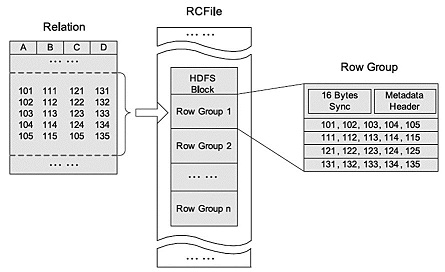首页 > 代码库 > Hive - Create Table&Drop Table & ALTER Table(上)
Hive - Create Table&Drop Table & ALTER Table(上)
写在前面:本来想着把表的创建,删除,以及修改一篇搞定的。结果看了一下,东西还是蛮多的,而且也是很多经常使用的操作。所以,就暂且分开处理吧。
特别提醒:在日常不管是创建库、表还是修改字段,删除等操作,建议都加上 [IF NOT EXISTS] | [IF EXISTS] 选项;虽然是可选项,但是还是小心为上,万一你在操作时没有加库名,又操作错了,那你哭都找不到地方。
This chapter explains how to create a table and how to insert data into it. The conventions of creating a table in HIVE is quite similar to creating a table using SQL.
Create Table Statement
Create Table is a statement used to create a table in Hive. The syntax and example are as follows:
Syntax
CREATE [TEMPORARY] [EXTERNAL] TABLE [IF NOT EXISTS] [db_name.] table_name [(col_name data_type [COMMENT col_comment], ...)] [COMMENT table_comment] [ROW FORMAT row_format] [STORED AS file_format]
译注:hive中stored的 file_format目前有:(参考http://blog.csdn.net/yfkiss/article/details/7787742)
- TEXTFILE:默认格式,数据不做压缩,磁盘开销大,数据解析开销大。可结合Gzip、Bzip2使用(系统自动检查,执行查询时自动解压),但使用这种方式,hive不会对数据进行切分,从而无法对数据进行并行操作。
- SEQUENCEFILE:SequenceFile是Hadoop API提供的一种二进制文件支持,其具有使用方便、可分割、可压缩的特点。SequenceFile支持三种压缩选择:NONE, RECORD, BLOCK。 Record压缩率低,一般建议使用BLOCK压缩。
- RCFILE:RCFILE是一种行列存储相结合的存储方式。首先,其将数据按行分块,保证同一个record在一个块上,避免读一个记录需要读取多个block。其次,块数据列式存储,有利于数据压缩和快速的列存取。RCFILE文件示例:

- 自定义格式:当用户的数据文件格式不能被当前 Hive 所识别的时候,可以自定义文件格式。
用户可以通过实现inputformat和outputformat来自定义输入输出格式,参考代码:
.\hive-0.8.1\src\contrib\src\java\org\apache\hadoop\hive\contrib\fileformat\base64
Example
Let us assume you need to create a table named employee using CREATE TABLE statement. The following table lists the fields and their data types in employee table:
| Sr.No | Field Name | Data Type |
|---|---|---|
| 1 | Eid | int |
| 2 | Name | String |
| 3 | Salary | Float |
| 4 | Designation | string |
The following data is a Comment, Row formatted fields such as Field terminator, Lines terminator, and Stored File type.
COMMENT ‘Employee details’ FIELDS TERMINATED BY ‘\t’ LINES TERMINATED BY ‘\n’ STORED IN TEXT FILE
The following query creates a table named employee using the above data.
hive> CREATE TABLE IF NOT EXISTS employee ( eid int, name String, salary String, destination String) COMMENT ‘Employee details’ ROW FORMAT DELIMITED FIELDS TERMINATED BY ‘\t’ LINES TERMINATED BY ‘\n’ STORED AS TEXTFILE;
译注:目前我使用的脚本样例如下:按照dt 字段进行分区,这个后续有一篇专门讲到了分区,你可以先去看看英文版https://www.tutorialspoint.com/hive/hive_partitioning.htm
CREATE TABLE IF NOT EXISTS `snapshot_task_sub` ( `task_sub_id` INT COMMENT ‘任务扩展子表ID‘, `task_id` INT COMMENT ‘任务ID‘, `car_series` INT COMMENT ‘车系ID‘, `series_name` STRING COMMENT ‘车系名称‘, `purchase_amount` INT COMMENT ‘购买数量‘, `price` DOUBLE COMMENT ‘最新投放单价‘, `published_price` DOUBLE COMMENT ‘刊例价‘, `state` TINYINT COMMENT ‘状态 0正常 2删除‘, `create_time` STRING COMMENT ‘创建时间‘, `edit_time` STRING COMMENT ‘修改时间‘, `snap_time` STRING COMMENT ‘快照时间‘ ) COMMENT ‘任务子表天快照表‘ PARTITIONED BY (`dt` STRING) ROW FORMAT DELIMITED FIELDS TERMINATED BY ‘\t‘ STORED AS TEXTFILE ;
If you add the option IF NOT EXISTS, Hive ignores the statement in case the table already exists.
On successful creation of table, you get to see the following response:
OK Time taken: 5.905 seconds hive>
JDBC Program
The JDBC program to create a table is given example.
import java.sql.SQLException; import java.sql.Connection; import java.sql.ResultSet; import java.sql.Statement; import java.sql.DriverManager; public class HiveCreateTable { private static String driverName = "org.apache.hadoop.hive.jdbc.HiveDriver"; public static void main(String[] args) throws SQLException { // Register driver and create driver instance Class.forName(driverName); // get connection Connection con = DriverManager.getConnection("jdbc:hive://localhost:10000/userdb", "", ""); // create statement Statement stmt = con.createStatement(); // execute statement stmt.executeQuery("CREATE TABLE IF NOT EXISTS " +" employee ( eid int, name String, " +" salary String, destignation String)" +" COMMENT ‘Employee details’" +" ROW FORMAT DELIMITED" +" FIELDS TERMINATED BY ‘\t’" +" LINES TERMINATED BY ‘\n’" +" STORED AS TEXTFILE;"); System.out.println(“ Table employee created.”); con.close(); } }
Save the program in a file named HiveCreateDb.java. The following commands are used to compile and execute this program.
$ javac HiveCreateDb.java $ java HiveCreateDb
Output
Table employee created.
Load Data Statement
Generally, after creating a table in SQL, we can insert data using the Insert statement. But in Hive, we can insert data using the LOAD DATA statement.
While inserting data into Hive, it is better to use LOAD DATA to store bulk records. There are two ways to load data: one is from local file system and second is from Hadoop file system.
通常,在SQL中创建表之后,我们可以使用Insert语句插入数据。 但在Hive中,我们可以使用LOAD DATA语句插入数据。
在将数据插入Hive时,最好使用LOAD DATA来存储批量记录。 有两种方式加载数据:一种来自本地文件系统,另一种来自Hadoop文件系统。
Syntax
The syntax for load data is as follows:
LOAD DATA [LOCAL] INPATH ‘filepath‘ [OVERWRITE] INTO TABLE tablename [PARTITION (partcol1=val1, partcol2=val2 ...)]
- LOCAL is identifier to specify the local path. It is optional. LOCAL是用于指定本地路径的标识符,可选参数
- OVERWRITE is optional to overwrite the data in the table. -- 如果指定了OVERWRITE,那么会覆盖表内所有数据,慎重
- PARTITION is optional.可选参数
Example
We will insert the following data into the table. It is a text file named sample.txt in /home/user directory.
1201 Gopal 45000 Technical manager 1202 Manisha 45000 Proof reader 1203 Masthanvali 40000 Technical writer 1204 Kiran 40000 Hr Admin 1205 Kranthi 30000 Op Admin
The following query loads the given text into the table.
hive> LOAD DATA LOCAL INPATH ‘/home/user/sample.txt‘ OVERWRITE INTO TABLE employee;
On successful download, you get to see the following response:
OK Time taken: 15.905 seconds hive>
JDBC Program
Given below is the JDBC program to load given data into the table.
import java.sql.SQLException; import java.sql.Connection; import java.sql.ResultSet; import java.sql.Statement; import java.sql.DriverManager; public class HiveLoadData { private static String driverName = "org.apache.hadoop.hive.jdbc.HiveDriver"; public static void main(String[] args) throws SQLException { // Register driver and create driver instance Class.forName(driverName); // get connection Connection con = DriverManager.getConnection("jdbc:hive://localhost:10000/userdb", "", ""); // create statement Statement stmt = con.createStatement(); // execute statement stmt.executeQuery("LOAD DATA LOCAL INPATH ‘/home/user/sample.txt‘" + "OVERWRITE INTO TABLE employee;"); System.out.println("Load Data into employee successful"); con.close(); } }
Save the program in a file named HiveLoadData.java. Use the following commands to compile and execute this program.
$ javac HiveLoadData.java
$ java HiveLoadData
Output:
Load Data into employee successful
-------------
英文文章地址:https://www.tutorialspoint.com/hive/hive_create_table.htm
Hive - Create Table&Drop Table & ALTER Table(上)
